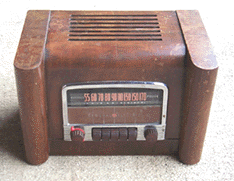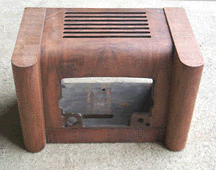
|
|
|
As found, the lacquer finish was coming off the case in many spots. This is pretty common on radios of this vintage, and usually requires that the radio be stripped and completely refinished. The wood appeared to be in excellent shape. This case appears to be solid walnut, as opposed to walnut veneer. It is extremely heavy.
Electronically, the radio did not work as found. It would power up, but I was not able to tune in any stations.
Cabinet Restoration
After examinining the finish, I decided the best thing to do would be
to remove the old lacquer finish and re-lacquer the radio. As you can
see from the image on the right, the lacquer finish has started to flake
off, leaving a rough and unattrative finish. This is quite typical
of antinque radios. It seems that very few have made it this far
without having some sort of damage to the lacquer. In some cases it is
possible to "restore" a finish without actually stripping, but this one
was just too far gone. I used a furniture refinisher product and #000
steel wool to remove the old finish. This took about 25 minutes. The
stripped radio cabinet is shown below.


The wood on this cabinet is simply beautiful, and stripping off the old finish (and no doubt years of grime, wax, and polish) really brought the wood to life. You can see the grain patterns now on the front which were not visible through the old finish.
After stripping the radio, I applied a light coat of special walnut stain. This evened out the color somewhat, without darkening the wood too much. The wood on this radio was really in terrific shape. I didn't do any sanding or other work, besides rubbing the case down with #0000 steel wool.
The next step was to apply a clear lacquer coat to seal and protect the wood. I used Mohawk's Satin Clear. I put on about 10 coats, with a light sanding of #0000 steel wool in between each coat. This gives a nice, rich, smooth finish that is historically accurate. I also cleaned and polished the dial glass and chrome trim. The completed radio is shown on the right.

|
|
|
Electronic Restoration
The radio was able to power up, but I received no stations. I pulled the chassis from the radio prior to beginning work on the cabinet. The tubes all tested fine. I started by replacing the electrolytic and paper capacitors. Once that was done, I also tested all the resistors to make sure they were within specifications. By this point, the radio worked, though it does not work terribly well. The volume is a little weak, and it does not pick up many stations. At this point, I'm going to consider it good enough, and move on to other projects. Perhaps in the future when my electronics skills are better, I will take a second look at this radio.